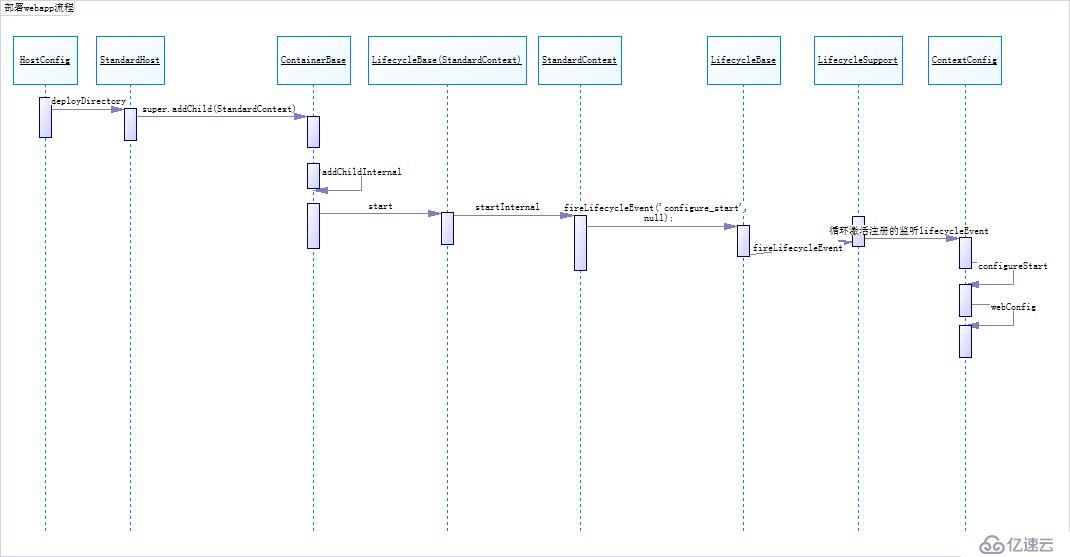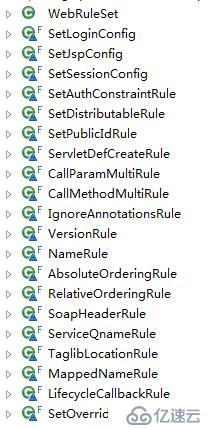您好,登錄后才能下訂單哦!
您好,登錄后才能下訂單哦!
熟悉java web開發的同學都清楚,tomcat作為一款非常流行的servlet容器,開源,流行,配置簡單,不需要贅述。個人認為,web.xml作為webapp的入口,弄清楚該文件的底層解析過程,進而可以窺探tomcat的底層工作機制,搞明白tomcat對servlert規范的實現機理。
通過本文,可以知道以下部分內容
webapp部署3種部署方式
webapp web.xml解析流程
webapp Context對象信息的生成(不包括對象的生成)
總體來說,webapp部署有三種方式:XML文件描述符、WAR包、文件目錄。三種方式部署的總體流程很相似,都是一個web應用分配一個線程來處理,這里統一放到與Host內部的線程池對象中(startStopExecutor),所以有時會看到在默認配置下Tomcat啟動后可能有一個叫“-startStop-”的線程還會運行一段時間才結束。但瀏覽這三種部署方式的實現代碼,里面都是構建一個Context對象,并將構建好的Context對象與Host組件關聯起來。
1.三種部署方式
/**
* 部署應用,該方法被org.apache.catalina.startup.HostConfig.start()調用
* 包含3種部署方式,每個部署方式分別使用內部類,分配一個線程處理
*/
protected void deployApps() {
File appBase = appBase();
File configBase = configBase();
String[] filteredAppPaths = filterAppPaths(appBase.list());
// Deploy XML descriptors from configBase
deployDescriptors(configBase, configBase.list());
// Deploy WARs
deployWARs(appBase, filteredAppPaths);
// Deploy expanded folders
deployDirectories(appBase, filteredAppPaths);
}3個部署的內部類
org.apache.catalina.startup.HostConfig.DeployWar
org.apache.catalina.startup.HostConfig.DeployDescriptor
org.apache.catalina.startup.HostConfig.DeployDirectory
2.從部署webapp到解析web.xml序列圖

找了很多網上資料,對從部署webapp開始,到開始解析web.xml這一段處理過程,沒找到相關資料。個人就花時間整理出這個序列圖,填補下這方面的空缺。通過該圖,可以很清楚的知道,這部分主要完成了2件事:
(1)啟動StandardContext,并將context對象添加到StandardHost對象中。
(2)通過觸發事件機制,開始Context的解析過程。
3.web.xml解析過程
接第二步驟中序列圖,開始分析web.xml的解析過程。從ContextConfig開始。
3.1 org.apache.catalina.startup.ContextConfig.configureStart()
/**
* Process a "contextConfig" event for this Context.
*/
protected synchronized void configureStart() {
// Called from StandardContext.start()
webConfig();
if (ok) {
validateSecurityRoles();
}
// Configure an authenticator if we need one
if (ok)
authenticatorConfig();
// Make our application available if no problems were encountered
if (ok)
context.setConfigured(true);
else {
log.error(sm.getString("contextConfig.unavailable"));
context.setConfigured(false);
}
}該方法通過調用webConfig(),具體完成解析工作,此外完成了安全驗證相關內容。
3.2 org.apache.catalina.startup.ContextConfig.webConfig()方法
/**
* Scan the web.xml files that apply to the web application and merge them
* using the rules defined in the spec. For the global web.xml files,
* where there is duplicate configuration, the most specific level wins. ie
* an application's web.xml takes precedence over the host level or global
* web.xml file.
*/
protected void webConfig() {
Set<WebXml> defaults = new HashSet<WebXml>();
defaults.add(getDefaultWebXmlFragment());
WebXml webXml = createWebXml();
// Parse context level web.xml
InputSource contextWebXml = getContextWebXmlSource();
parseWebXml(contextWebXml, webXml, false);//解析
ServletContext sContext = context.getServletContext();
// Ordering is important here
// Step 1. Identify all the JARs packaged with the application
// If the JARs have a web-fragment.xml it will be parsed at this
// point.
Map<String,WebXml> fragments = processJarsForWebFragments(webXml);
// Step 2. Order the fragments.
Set<WebXml> orderedFragments = null;
orderedFragments =
WebXml.orderWebFragments(webXml, fragments, sContext);
// Step 3. Look for ServletContainerInitializer implementations
if (ok) {
processServletContainerInitializers();
}
// Step 5. Process JARs for annotations - only need to process
// those fragments we are going to use
if (ok) {
processAnnotations(
orderedFragments, webXml.isMetadataComplete());
}
// Cache, if used, is no longer required so clear it
javaClassCache.clear();
}
// Step 6. Merge web-fragment.xml files into the main web.xml
// Step 7. Apply global defaults
webXml.merge(defaults);
// Step 8. Convert explicitly mentioned jsps to servlets
convertJsps(webXml);
// Step 9. Apply merged web.xml to Context
webXml.configureContext(context);
// Step 9a. Make the merged web.xml available to other
// components,
// Always need to look for static resources
// Step 10. Look for static resources packaged in JARs
proce***esourceJARs(resourceJars);
// See also StandardContext.resourcesStart() for
// WEB-INF/classes/META-INF/resources configuration
// Step 11. Apply the ServletContainerInitializer config to the
// context
context.addServletContainerInitializer(
entry.getKey(), entry.getValue());
}通過源碼中的注釋,step1 到step11。主要工作包含:1.解析xml,2.合并xml,3.組裝Context,4.編譯JSP。具體步驟,參考說明
掃描應用打包的所有Jar來檢索Jar包里面的web.xml配置并解析,放入內存。
對這些已經檢索到的web配置進行排序。
基于SPI機制查找ServletContainerInitializer的實現,寫web中間件的同學注意了,了解SPI以及 ServletContainerInitializer機制這對于你來說可能是一個很好的知識點。
處理/WEB-INF/classes下面的類的注解,某個版本Servlet支持注解方式的配置,可以猜測相關事宜就是在這里干的。
處理Jar包中的注解類。
將web配置按照一定規則合并到一起。
應用全局默認配置,還記得Tomcat包下面的conf文件夾下面有個web.xml配置文件吧。
將JSP轉換為Servlet,這讓我想起了若干年前對JSP的理解。
將web配置應用到Servlet上下文,也即Servlet容器。
將配置信息保存起來以供其他組件訪問,使得其他組件不需要再次重復上面的步驟去獲取配置信息了。
檢索Jar包中的靜態資源。
將ServletContainerInitializer配置到上下文。
3.3 org.apache.catalina.startup.ContextConfig.parseWebXml方法
/**
* Parses the given source and stores the parsed data in the given web.xml
* representation. The byte stream will be closed at the end of the parse
* operation.
*
* @param source Input source containing the XML data to be parsed
* @param dest The object representation of common elements of web.xml and
* web-fragment.xml
* @param fragment Specifies whether the source is web-fragment.xml or
* web.xml
*/
protected void parseWebXml(InputSource source, WebXml dest,
boolean fragment) {
XmlErrorHandler handler = new XmlErrorHandler();
Digester digester;
WebRuleSet ruleSet;
if (fragment) {
digester = webFragmentDigester;
ruleSet = webFragmentRuleSet;
} else {
digester = webDigester;
ruleSet = webRuleSet;
}
digester.push(dest);
digester.setErrorHandler(handler);
digester.parse(source);
}使用Digester 對象即系web.xml,并將結果保存到WebXml對象中。
3.4 Digester的解析規則
(1)構造Digester.createWebXmlDigester
public void createWebXmlDigester(boolean namespaceAware,
boolean validation) {
boolean blockExternal = context.getXmlBlockExternal();
webRuleSet = new WebRuleSet(false);
webDigester = DigesterFactory.newDigester(validation,
namespaceAware, webRuleSet, blockExternal);
webDigester.getParser();
webFragmentRuleSet = new WebRuleSet(true);
webFragmentDigester = DigesterFactory.newDigester(validation,
namespaceAware, webFragmentRuleSet, blockExternal);
webFragmentDigester.getParser();
}(2)配置解析規則 WebRuleSet.addRuleInstances
/**
* <p>Add the set of Rule instances defined in this RuleSet to the
* specified <code>Digester</code> instance, associating them with
* our namespace URI (if any). This method should only be called
* by a Digester instance.</p>
*
* @param digester Digester instance to which the new Rule instances
* should be added.
*/
@Override
public void addRuleInstances(Digester digester) {
digester.addRule(fullPrefix,
new SetPublicIdRule("setPublicId"));
digester.addRule(fullPrefix,
new IgnoreAnnotationsRule());
digester.addRule(fullPrefix,
new VersionRule());
// Required for both fragments and non-fragments
digester.addRule(fullPrefix + "/absolute-ordering", absoluteOrdering);
digester.addRule(fullPrefix + "/ordering", relativeOrdering);
if (fragment) {
// web-fragment.xml
digester.addRule(fullPrefix + "/name", name);
digester.addCallMethod(fullPrefix + "/ordering/after/name",
"addAfterOrdering", 0);
digester.addCallMethod(fullPrefix + "/ordering/after/others",
"addAfterOrderingOthers");
digester.addCallMethod(fullPrefix + "/ordering/before/name",
"addBeforeOrdering", 0);
digester.addCallMethod(fullPrefix + "/ordering/before/others",
"addBeforeOrderingOthers");
} else {
// web.xml
digester.addCallMethod(fullPrefix + "/absolute-ordering/name",
"addAbsoluteOrdering", 0);
digester.addCallMethod(fullPrefix + "/absolute-ordering/others",
"addAbsoluteOrderingOthers");
}
digester.addCallMethod(fullPrefix + "/context-param",
"addContextParam", 2);
digester.addCallParam(fullPrefix + "/context-param/param-name", 0);
digester.addCallParam(fullPrefix + "/context-param/param-value", 1);
digester.addObjectCreate(fullPrefix + "/filter",
"org.apache.catalina.deploy.FilterDef");
digester.addSetNext(fullPrefix + "/filter",
"addFilter",
"org.apache.catalina.deploy.FilterDef");
digester.addCallMethod(fullPrefix + "/filter/description",
"setDescription", 0);
digester.addCallMethod(fullPrefix + "/filter/display-name",
"setDisplayName", 0);
digester.addCallMethod(fullPrefix + "/filter/filter-class",
"setFilterClass", 0);
digester.addCallMethod(fullPrefix + "/filter/filter-name",
"setFilterName", 0);
digester.addCallMethod(fullPrefix + "/filter/icon/large-icon",
"setLargeIcon", 0);
digester.addCallMethod(fullPrefix + "/filter/icon/small-icon",
"setSmallIcon", 0);
digester.addCallMethod(fullPrefix + "/filter/async-supported",
"setAsyncSupported", 0);
digester.addCallMethod(fullPrefix + "/filter/init-param",
"addInitParameter", 2);
digester.addCallParam(fullPrefix + "/filter/init-param/param-name",
0);
digester.addCallParam(fullPrefix + "/filter/init-param/param-value",
1);
digester.addObjectCreate(fullPrefix + "/filter-mapping",
"org.apache.catalina.deploy.FilterMap");
digester.addSetNext(fullPrefix + "/filter-mapping",
"addFilterMapping",
"org.apache.catalina.deploy.FilterMap");
digester.addCallMethod(fullPrefix + "/filter-mapping/filter-name",
"setFilterName", 0);
digester.addCallMethod(fullPrefix + "/filter-mapping/servlet-name",
"addServletName", 0);
digester.addCallMethod(fullPrefix + "/filter-mapping/url-pattern",
"addURLPattern", 0);
digester.addCallMethod(fullPrefix + "/filter-mapping/dispatcher",
"setDispatcher", 0);
digester.addCallMethod(fullPrefix + "/listener/listener-class",
"addListener", 0);
...
}在這個方法里,可以看到熟悉的“/servlet/servlet-name”,"/listener/listener-class"等等。稍微懂點Digester解析語法的基礎的朋友,立刻可以知道這兒就是解析規則所在,Digester解析web.xml規則都是在此配置的。進一步梳理下,可以弄明白servlet,filter等重要對象的數據載體。
| 標簽 | 數據載體類 |
| /filter | org.apache.catalina.deploy.FilterDef |
| /error-page | org.apache.catalina.deploy.ErrorPage |
| /servlet | org.apache.catalina.deploy.ServletDef |
| /filter-mapping | org.apache.catalina.deploy.FilterMap |
| /login-config | org.apache.catalina.deploy.LoginConfig |
| /session-config | org.apache.catalina.deploy.SessionConfig |
| ... | ... |
部分私有內部Rule列表

通過分析,可以知道web.xml通過解析之后,配置信息都保存在WebXml對象中了。
WebXml中持有FilterMap,ServletDef,FilterDef等等對象的聚集信息。接下來tomcat就可以按照servlet規范初始化里面的組件了,有空將進一步介紹。
免責聲明:本站發布的內容(圖片、視頻和文字)以原創、轉載和分享為主,文章觀點不代表本網站立場,如果涉及侵權請聯系站長郵箱:is@yisu.com進行舉報,并提供相關證據,一經查實,將立刻刪除涉嫌侵權內容。